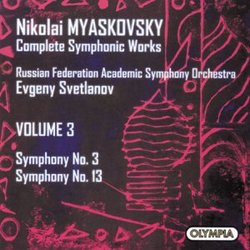| All Artists: Myaskovsky, Svetlanov Title: Myaskovsky: Complete Symphonic Works, Volume 3: Symphonies Nos. 3 & 13 Members Wishing: 0 Total Copies: 0 Label: Olympia Original Release Date: 1/1/2002 Re-Release Date: 6/25/2002 Genre: Classical Styles: Historical Periods, Modern, 20th, & 21st Century, Symphonies Number of Discs: 1 SwapaCD Credits: 1 UPCs: 5015524407339, 515524407339 |
Search - Myaskovsky, Svetlanov :: Myaskovsky: Complete Symphonic Works, Volume 3: Symphonies Nos. 3 & 13
 | Myaskovsky, Svetlanov Myaskovsky: Complete Symphonic Works, Volume 3: Symphonies Nos. 3 & 13 Genre: Classical
|
Larger Image |
CD DetailsSimilar CDs
|
CD ReviewsImportant Series of an Important yet underrated Soviet III David A. Hollingsworth | Washington, DC USA | 11/27/2002 (5 out of 5 stars) "Alexei A. Ikonnikov, Myaskovsky's chief biographer, describes the Thirteenth as the following: "The music of the Thirteenth Symphony moves through a comparatively narrow circle of moods `strange in the extreme,' woven of a despondency and spiritual desolation verging on stupor and punctuated with sudden emotional rises and falls, the exact psychological basis of which is hard to determine." The one movement Thirteenth Symphony (of 1932) is truly a masterpiece and a huge step further from the Twelfth in adapting to changes in the political and social climates in the Stalinist Regime, though not without struggles. As generally noted, the Twelfth Symphony (1931), dedicated to the 15th Anniversary of the October Revolution, represents the turning point of the composer; from the personal to the objective. With the political climate changing towards Socialist Realism (which marked the end of the Avant Garde movement), Myaskovsky chose to compose music not so much on a personal level, but in a manner listeners in Soviet Russia can relate to while still having a personality essentially of his own. He was, however, capable of reaching listeners beyond Soviet borders and the appeal of his music is, therefore, rather cosmopolitan. The path Myaskovsky had chosen was not easy and he was not always successful, but he remained because of it an honest and a self-critical musical artist. Needles to say, the Thirteenth Symphony is not an easy piece even for Myaskovsky. There is substance behind his music, but more on the abstract and the ambiguous and the mood is as bleak as his earlier symphonies, such as the Third, Fourth, Sixth and the Tenth. It has embedded within a certain linear constructivism that Prokofiev could relate to. But it's rather remarkable that this score was never before recorded and not so accessible, for it anticipates some of the Avant Garde tendencies of the 1960s and beyond (and composers such as Schnikke and Denisov come to mind particularly, and perhaps even Tubin in his later symphonies like the Eighth). If the Twelfth Symphony represents the turning point from the personal to the objective, the Thirteenth solidifies that turning point, but in ways that suggest more of an inner struggle and conflict amidst the political and social changes in Soviet Russia.The Third Symphony of 1913 is not quite a masterpiece in comparison with his Thirteenth. It has a number of flaws; namely, the thematic ideas that hardly at all develop into something of true symphonic coherence (and the turgid scoring does not help matters any). Nevertheless, the score is rather interesting in its own right. The introduction and some of the ensuing passages have Scriabin written all over it (and is reminiscent of, say, Scriabin's Second Symphony-first movement). And some of the manic expressionism evokes Mahler and to extent, Wagner and Rachmaninov, while chromatically Franckian. However, the slow passages are the most memorable; with Myaskovsky's introspection which conveys depth and soul searching. The mystique-ending first movement, announced by string tremolo and woodwinds, is especially compelling. The second movement begins with a theme temperamentally fiery in mannerism, and there are some accidental sprinkles of Elgar that are detectable. But, turn to the slow passage (@5'44"-9'55"), and you'll notice the ideas that are clearly wrought and imaginative. The passage has nobility, dignity, and a certain magic and mournfulness that brings to mind Stanford (the slow movement of his Irish Symphony) and Elgar. The funeral march (@16'22"-ff) is likewise remarkable. It has this tone of gloom and denouncement that upon hearing, Tchaikovsky and Mahler would've been proud to walk over towards Myaskovsky and claim him as their brother. The depth and substance behind this march, and in the slow passages of the two movements, would compel me to take them anywhere in this globe while leaving the rest of the Symphony behind, for they simply represent the best of what Myaskovsky had to offer; composing music capable of moving those from within. So, while this Symphony is not flawless, even by a long shot, it nevertheless serves as an effective precursor to the masterpiece Sixth and Thirteenth Symphonies (written ten and nineteen years later, respectively). Therefore, those familiar with or interested in these symphonies should give the Third a try. Svetlanov's authoritative accounts of the Symphonies are never in question (and his rendition of the Thirteenth is especially excellent). The Russian Federation Symphony Orchestra give us its enthusiastic and imaginative communication. Oh,.... and one extra bonus? Per Skans detailed and informative booklet essay, which is in a class of its own (to say the least)."
|

 Track Listings (3) - Disc #1
Track Listings (3) - Disc #1


